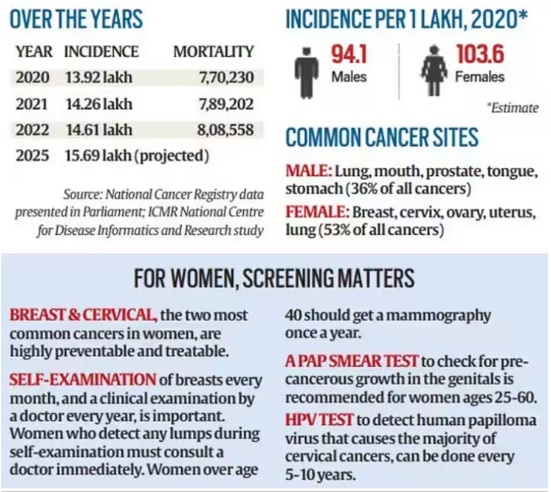Social Justice
Women, Power and Cancer: Lancet
- 30 Sep 2023
- 7 min read
For Prelims: Women, Power and Cancer: Lancet, Cancer, Gender Inequity, Human Development Index, Years of Life Lost (YLLs), Lancet Global Health, Hepatitis B and C infections.
For Mains: Women, Power and Cancer: Lancet, Cancer Prevention.
Why in News?
Recently, The Lancet Global Health has released a report titled-“Women, Power and Cancer”, which highlights how societal apathy towards women’s health has delayed their access to Cancer prevention.
What is the Methodology of the Study?
- This study estimated premature deaths at ages 30–69 years and distinguished these as deaths that are preventable or treatable in 185 countries worldwide.
- For this population-based study, estimated Cancer deaths by country, cancer, sex, and age groups were retrieved from the International Agency for Research on Cancer's GLOBOCAN 2020 database.
- Crude and age-adjusted cancer-specific Years of Life Lost (YLLs) were calculated for 36 cancer types.
What are the Findings of the Report?
- Cancer-Related Mortality and Burden:
- In 2020, there were 5.28 million premature cancer-related deaths worldwide, occurring between the ages of 30 and 69.
- These premature deaths resulted in a significant burden of 182.8 million years of life lost (YLLs), accounting for 68.8% of the total YLLs from cancer across all age groups.
- Preventable and Treatable Deaths:
- Among the premature YLLs, 68% were deemed preventable, achievable through primary prevention or early detection efforts.
- The remaining 32.0% YLLs were considered treatable, where effective evidence-based treatment with curative intent could reduce mortality.
- Gender Disparities:
- Men experienced a higher proportion of preventable premature YLLs compared to women (70.3% for men vs. 65.2% for women).
- However, the proportion of treatable premature YLLs was higher for women than for men (34.8% for women vs. 29.7% for men).
- Human Development Index (HDI) and Mortality:
- Countries with lower HDI levels had greater proportions of YLLs at premature ages compared to very high HDI countries.
- Lung cancer was a major contributor to preventable premature YLLs in medium to very high HDI countries, while cervical cancer led in low HDI countries.
- Colorectal and breast cancers were major treatable cancers across all tiers of HDI.
What are the Key Highlights of the Study Pertaining to India?
- Cancer Deaths Among Women in India:
- Nearly 63% of cancer deaths among women in India could have been prevented by reducing risk factors, screening, or early diagnosis.
- 37% of deaths could have been averted with appropriate and timely treatment.
- Challenges and Factors Affecting Cancer Care for Women:
- Societal apathy towards women’s health, lack of awareness, and absence of quality expertise at the primary care level delayed access to cancer prevention, detection, and care for women.
- Gender Gap and Discrimination in Healthcare:
- Because of Gender Inequity in cancer care, a woman's health concerns were dismissed or ignored.
- Women are less likely to be in a position of power and may face difficulty in determining their care due to gender bias and discrimination.
- Leading Risk Factors Among Women in India:
- The top three cancers among women in India are Breast, Cervical, and Ovarian Cancers.
- One woman dies from cervical cancer every eight minutes.
- Infection continues to be the biggest risk factor for cancer in Indian women, contributing to 23% of deaths.
- Infections that increase the risk of cancers include the HPV virus, which causes cervical cancer, and Hepatitis B and C infections that increase the risk of liver cancer.
- Tobacco is the second important risk factor, contributing to 6% of the cancer deaths.
- Alcohol and obesity each contributed to 1% cancer mortality in India.
- Economic and Social Impact:
- BRICS (Brazil, Russia, India, China, South Africa) nations lost out on USD 46.3 billion because of productivity loss as a result of premature cancer deaths.
- The value of unpaid cancer care-giving by women is about 3.66 of India’s national health expenditure.
What are the Recommendations of the Report?
- There is a need to call for a new feminist and inclusive agenda for cancer care, aiming to address the gender disparities and challenges women face in accessing appropriate cancer prevention, detection, and treatment.
- There is a need for more sex- and gender-inclusive policies and guidelines, addressing long-standing discriminatory practices undermining women’s interaction with the health system.
- There should be tailored programs for early diagnosis, screening, comprehensive treatment, risk factor reduction, and vaccination to address premature cancer inequalities.
- Screening is crucial for early detection and prevention of breast and cervical cancers.
- Self-examination of breasts every month and clinical examination by a doctor every year is advised.
- Women over the age of 40 should get a mammography once a year to check for breast cancer.
- Women between the ages of 25 and 65 years should get a pap smear test to check for pre-cancerous growth on their cervix.
Why are Women More Precarious to Dying of Cancer?
- Many women in India face barriers in accessing healthcare. Their headaches, stemming from a developing brain cancer, are ignored generally in many cases.
- There is a need of addressing societal apathy towards women's health, lack of awareness, and absence of quality healthcare at the primary level.
- The challenges faced by dispossessed women, including early marriage, lack of education, and financial dependence, hinder their ability to seek medical attention and sustain treatment.
- Lack of knowledge and delayed diagnosis by local healthcare providers can severely impact a patient's prognosis and quality of life.







